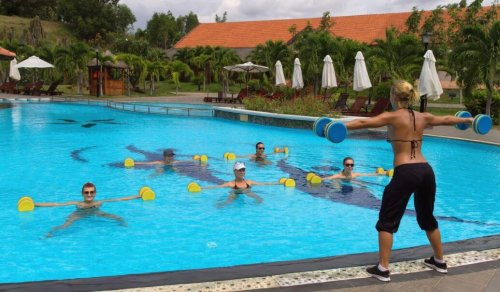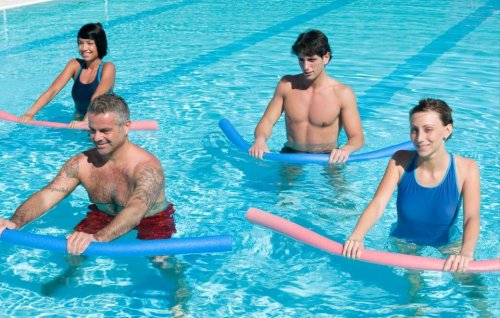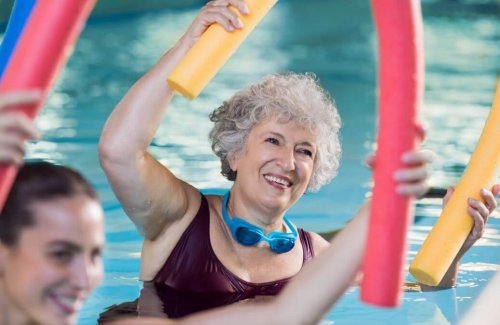What is Water Aerobics?

Water aerobics is a physical activity where aerobic exercises, which require the constant supply of oxygen through breathing, converge with swimming.
In this article we will look at the benefits, methods and examples of water aerobics.
The water aerobics method
The method of performing water aerobics consists of physical routines that are carried out partially submerged in lukewarm water (between 82 and 87 degrees Fahrenheit), that is, in a swimming pool. It doesn’t have to be an Olympic size pool—a height between 1.2 and 1.5 m is deep enough.

The reason that the water should be lukewarm, is because cold water doesn’t assist with easy breathing. If the water is too hot, it can produce fatigue and possibly dizziness. Therefore, the temperature should be consistent with our bodies to help us to perform physical activity.
This sport is also known as hydro gym and aquatic aerobics. There are also several derivatives, such as: aqua-running, aqua-cycling, aqua-boxing, aqua-lates, aichi, woga, and aqua-rhythms.
Although swimming alone provides numerous physical and health benefits, not everybody is capable of achieving the effort that it requires.
Water aerobics provides a method that effectively moves the entire body, aided by the resistance that the density of the water creates. Muscles, joints, and bones are all enhanced by this physical activity.
In addition to these benefits, it’s also really pleasant to work out in water, added to the fact that these types of activities are designed to be performed in groups.
Moreover, water aerobics is suitable for all ages and physical conditions. In fact, it’s recommended for people who suffer with fibromyalgia, osteoarthritis, osteoporosis, and other serious pathologies.
The practice of water aerobics, (in some of its variations), requires the use of accessories, such as noodles (foam rubber cylinders), weights or dumbbells, anklets, and neoprene gloves. You could also use the structure of the pool, for example, its wall and steps.
What does water aerobics consists of?

Depending on the movement in question, the water environment can facilitate or offer resistance when carrying out exercises in it. This resistance is useful for generating muscular strength.
Although it’s a low impact activity, its exercises can be classified as low, medium, and high impact movements. Beginners should start at the lowest level of impact.
Those who start doing water aerobics shouldn’t force themselves to perform the most demanding exercises in the first sessions. Thus, avoiding injuries, and because the benefits are only obtained if the training is progressive.
As with any type of exercise, it’s necessary to warm up for about 10 minutes beforehand. This usually consists of walking underwater for a period of time with varied speeds and intensity.
It’s also great to include music in the routines, especially rhythms that serve as a guide for the duration of movements. The workout shouldn’t start immediately after eating; leave at least two hours between eating and performing water aerobics.
Examples of water aerobic exercises
Almost all the water aerobic routines include the following movements, among many others:
- Marching and racing.
- Pedaling and kicking
- Squats
- Jumping
- Knee lifts
- Tiptoe exercises
- Twists
- Scissor jumps
- Suspension, with or without flotation devices
- Climbing up and down steps (aquastep)

Every exercise session must finish with stretching in order to return the muscles to their initial state of relaxation. New techniques arise every day, driven by the creativity of practitioners and coaches.
The movements made in water aerobics have many variations. The effectiveness of any exercise is affected by execution time, the number of sets and repetitions, limb coordination, and the combinations.
Benefits of practicing water aerobics
In addition to strengthening the core, there are various other benefits to be enjoyed too:
- It’s a very entertaining activity, favored for being group-centered.
- Improves blood circulation
- Favors cardiovascular health
- Provides muscle tone
- Improves resistance and flexibility
- Enhances respiratory capacity
- Decreases body fat percentage and prevents weight gain
- Prevents many diseases associated with a sedentary lifestyle and obesity
- Reduces stress and aids mental well-being and self-esteem
- Fights depression and boosts good moods
- Reduces physical pain, depending on its cause
- It’s an exceptionally energizing activity.
In addition to practicing this type of exercise, it’s essential to maintain a healthy lifestyle that includes a balanced diet and proper nutrition.
Water aerobics is a physical activity where aerobic exercises, which require the constant supply of oxygen through breathing, converge with swimming.
In this article we will look at the benefits, methods and examples of water aerobics.
The water aerobics method
The method of performing water aerobics consists of physical routines that are carried out partially submerged in lukewarm water (between 82 and 87 degrees Fahrenheit), that is, in a swimming pool. It doesn’t have to be an Olympic size pool—a height between 1.2 and 1.5 m is deep enough.

The reason that the water should be lukewarm, is because cold water doesn’t assist with easy breathing. If the water is too hot, it can produce fatigue and possibly dizziness. Therefore, the temperature should be consistent with our bodies to help us to perform physical activity.
This sport is also known as hydro gym and aquatic aerobics. There are also several derivatives, such as: aqua-running, aqua-cycling, aqua-boxing, aqua-lates, aichi, woga, and aqua-rhythms.
Although swimming alone provides numerous physical and health benefits, not everybody is capable of achieving the effort that it requires.
Water aerobics provides a method that effectively moves the entire body, aided by the resistance that the density of the water creates. Muscles, joints, and bones are all enhanced by this physical activity.
In addition to these benefits, it’s also really pleasant to work out in water, added to the fact that these types of activities are designed to be performed in groups.
Moreover, water aerobics is suitable for all ages and physical conditions. In fact, it’s recommended for people who suffer with fibromyalgia, osteoarthritis, osteoporosis, and other serious pathologies.
The practice of water aerobics, (in some of its variations), requires the use of accessories, such as noodles (foam rubber cylinders), weights or dumbbells, anklets, and neoprene gloves. You could also use the structure of the pool, for example, its wall and steps.
What does water aerobics consists of?

Depending on the movement in question, the water environment can facilitate or offer resistance when carrying out exercises in it. This resistance is useful for generating muscular strength.
Although it’s a low impact activity, its exercises can be classified as low, medium, and high impact movements. Beginners should start at the lowest level of impact.
Those who start doing water aerobics shouldn’t force themselves to perform the most demanding exercises in the first sessions. Thus, avoiding injuries, and because the benefits are only obtained if the training is progressive.
As with any type of exercise, it’s necessary to warm up for about 10 minutes beforehand. This usually consists of walking underwater for a period of time with varied speeds and intensity.
It’s also great to include music in the routines, especially rhythms that serve as a guide for the duration of movements. The workout shouldn’t start immediately after eating; leave at least two hours between eating and performing water aerobics.
Examples of water aerobic exercises
Almost all the water aerobic routines include the following movements, among many others:
- Marching and racing.
- Pedaling and kicking
- Squats
- Jumping
- Knee lifts
- Tiptoe exercises
- Twists
- Scissor jumps
- Suspension, with or without flotation devices
- Climbing up and down steps (aquastep)

Every exercise session must finish with stretching in order to return the muscles to their initial state of relaxation. New techniques arise every day, driven by the creativity of practitioners and coaches.
The movements made in water aerobics have many variations. The effectiveness of any exercise is affected by execution time, the number of sets and repetitions, limb coordination, and the combinations.
Benefits of practicing water aerobics
In addition to strengthening the core, there are various other benefits to be enjoyed too:
- It’s a very entertaining activity, favored for being group-centered.
- Improves blood circulation
- Favors cardiovascular health
- Provides muscle tone
- Improves resistance and flexibility
- Enhances respiratory capacity
- Decreases body fat percentage and prevents weight gain
- Prevents many diseases associated with a sedentary lifestyle and obesity
- Reduces stress and aids mental well-being and self-esteem
- Fights depression and boosts good moods
- Reduces physical pain, depending on its cause
- It’s an exceptionally energizing activity.
In addition to practicing this type of exercise, it’s essential to maintain a healthy lifestyle that includes a balanced diet and proper nutrition.
This text is provided for informational purposes only and does not replace consultation with a professional. If in doubt, consult your specialist.








